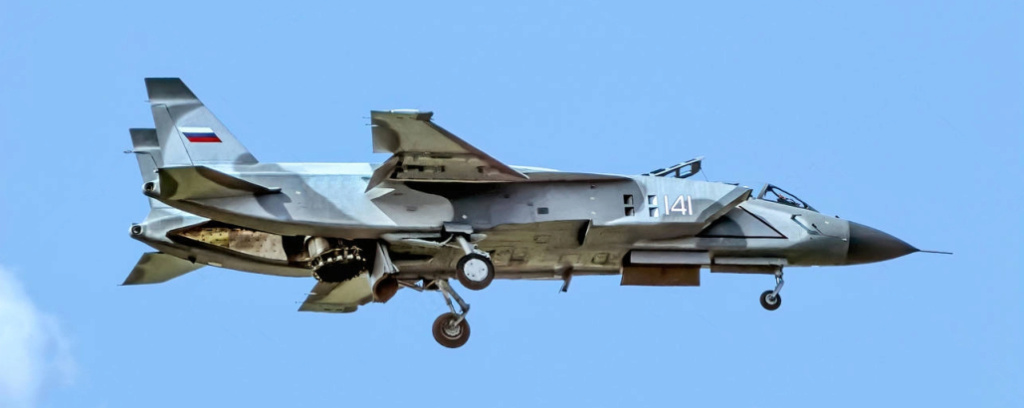Since we mentioned the Yak-41 VTOL fighter:

As far back as 1973 it was decided to develop a supersonic VTOL interceptor as a replacement for the Yak-38. By 1980 the layout and general arrangement of the Yak-41 was finalized. A two seat trainer version was also planned - the Yak-41UT.
The third Kiev class carrier Novorossiysk, was commissioned in 1982 and was supposed to have the Yak-41 on board but the development of the engines for the Yak-41 took a very long time to perfect and static tests only commenced in the second half of 1986.
Since the introduction of the Sea Harrier FRS2 and the other Harrier II's it became clear that a replacement for the Yak-38M was urgently needed. Such an aircraft was the Yak-41 which became known as the Yak-41M and later the Yak-141. The Harrier II and the Yak-41 were both 4th generation aircraft and the first flight of the Yak-41 was made two years after the Harrier II in 1987.
On 9 March 1987 the first prototype took to the air, performing a conventional take-off and landing. The first hover flight was performed by the second prototype late in December 1989 and in June 1990 the first "full spectrum" flights was performed including a short take-off run. By January 1991 the two flying prototypes performed 108 flights between them. The tests showed that the Yak-41 vastly outperformed the Harrier during full load tests.
The Yak-41 had a much more powerful avionics kit compared to the Yak-38, consisting of a pulse-Doppler radar , a laser rangefinder and electronic warfare equipment located in the wingtips and fuselage of the aircraft.
The R79V-300 thrust vectoring engine became the first engine in the world that allowed the use of afterburner both in horizontal and vertical flight modes. Thanks to the unique design of the main engine, the Yak-41 became the second aircraft after the French experimental Dassault Mirage IIIV, VTOL flying at supersonic speed.
The Yak-41's weapons systems was also much more diverse and more powerful than the Yak-38M and even the Harrier II. It was created as an all-weather multi-role aircraft for the Air Force (Yak-43) and Navy aviation. The Yak-43 differed from the Yak-41 in that it had a shorter takeoff (with a run-up length of 120 meters) and had a longer combat radius.
The Yak-43 was also a more stealthy design with internal weapons.Armament included the GSH-30-1 cannon, R-27, R-60, R-73 and R-77 air-to-air missiles and the Kh-25, Kh-31 and Kh-35 air-to-surface missiles on its four under wing hard points. The GSH-23L could also be suspended in gun pods. The Yak could also be armed with 80-240 mm rockets and could carry 6 bombs of all types up to 500 kg. It was a true multi-role fighter.
During the test flights, 12 world records were set on the Yak-41 for the rate of climb, maximum load and altitude of flight with cargo. Most importantly, these tests demonstrated complete superiority over the Harrier in all major aspects. The Yak-41's supersonic speed was perfectly within the actual air-to-air combat "dogfight" zone and it's thrust vectoring engine would have made it a very dangerous opponent.
The Yak-41 was slated to equip the Kiev and Tbilisi class carriers. The two flying prototypes commenced carrier flight trails on board the newest Kiev class carrier - Fleet Admiral Gorshkov (previously Baku).
Full-scale deck tests began on board the Admiral Gorshkov carrier when, two Yak-41 prototypes landed on an aircraft carrier on 26 September 1991. A few days later the first take-off was performed but it ended in a heavy crash on the landing approach. The pilot ejected safely. This accident was a big blow for the program, and it was also during that the USSR dissolved and the Yak-41 became one of many programs that were terminated.
The fire damaged prototype was repaired as a static and was displayed at international air shows under the bogus designation of Yak-141. Confusingly both the flying prototype and the one for static displays had the number "141 white" on the side.

The Yak-41 was a true show stopper and was displayed at the Paris Air Show in 1991 and the following year at Farnborough, where it performed some truly remarkable "Freestyle" maneuvers. Freestyle was the NATO name given to the Yak-41.
Many western observers credited the "Freestyle" as at least 15-20 years ahead of the nearest western rivals and this was confirmed when the Yakolev OKB's test pilot Andrey Sinitsen established 12 world records in the Yak-41 during April 1991 clearly demonstrating that the Yak-41 had no equal at the time.
Displaying the aircraft to the West resulted in the Yakovlev OKB's participation in a joint project with Lockheed to develop the JSF (Joint Strike Fighter) program.
Since then the Yakolev OKB has proposed various improved Yak-41 variants. This included the Yak-41M and the Yak-43 and also the "Next Generation" Mach 2 Yak.









